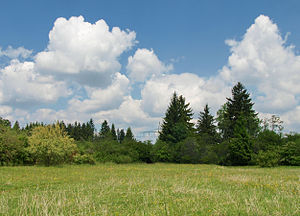Kissinger Heath
|
Nature reserve "Kissinger Heide"
|
||
|
The Kissinger Heide at the beginning of June looking north |
||
| location | Kissing , Aichach-Friedberg District , Swabia , Bavaria , Germany | |
| surface | 42.62 ha | |
| Identifier | NSG700.004 | |
| WDPA ID | 82069 | |
| Natura 2000 ID | DE-7631-371 | |
| Geographical location | 48 ° 18 ' N , 10 ° 57' E | |
|
|
||
| Sea level | from 502 m to 506 m | |
| Setup date | October 19, 1964 | |
| Framework plan | Land use plan with integrated landscape planning (2013) | |
| administration |
Government of Swabia, Subject 51 - Nature Conservation ; Maintenance by the Landschaftspflegeverband Aichach-Friedberg e. V. |
|
| particularities | Mass bloom of the Clusius gentian in spring | |
The Kissinger Heide is under nature conservation standing semi-dry grass area near the Swabian municipality Kissing . It is one of the Lech Valley heaths and is a relic of the once very large grasslands in the Lech near Augsburg . The area is known to botanists and nature lovers for its rare plants ; especially gentian and orchid species can be found there in large numbers. Even rare animals have a retreat here, for example various species of bluebell .
location
The Kissinger Heide lies east of the Lech approximately at the level of the southern outskirts of the eponymous municipality. While Kissing extends east of the Augsburg-Munich railway line, the heath is to the west of it. In the north, the area is bordered by Lechauenstrasse, which leads from Kissing over the track system to the Weitmannsee. In the west, the protected area borders on the parking lots of the local recreation area. The southwest corner extends almost to the lake shore. In the south, the heather ends on a line running diagonally to the east-south-east. In the east there are agricultural areas.
history
Until about the middle of the 19th century, the Kissinger Heide was a forest pasture . Thereafter, on the open grasslands to 1920 in the fall of a Streumahd performed on permanent hay as animal bedding to win. However, some areas were also afforested during this period. The area has been a nature reserve since June 6, 1941. Nevertheless, shortly afterwards an area of around 1 hectare in the northern section was released for gravel extraction, regardless of the orchid population there. Funding work did not end until 1961. In the first years after the war several agricultural interventions took place. On October 19, 1964, the protection status of the area was confirmed. But even after that, other heather areas were destroyed by gravel mining. Comprehensive maintenance measures were only introduced in 1980, in particular the annual mowing of the areas in order to prevent bush encroachment in favor of gentians and orchids, which need light. Under the direction of the Lower Nature Conservation Authority, voluntary nature conservationists from the local BN branch initially took on the mowing work, and later also spreading the cuttings on expansion areas in the vicinity. The area is now being maintained by the Aichach-Friedberg Landscape Management Association. Today the Kissinger Heide is a popular destination, which is why excursion paths have been created for visitors to prevent damage from being stepped on.
Heathland
Plants (selection)
Animals (selection)
|
literature
- Fritz Hiemeyer: Königsbrunner and Kissinger Heide . Nature guides. 2nd Edition. Wißner, 2006, ISBN 3-89639-335-9 ( excerpts from pilze-augsburg.de online - reports of the Natural Science Association for Swabia - special report 2002).
Web links
- Government of Swabia: General map and nature reserve maps for the ordinance on the nature reserve "Kissinger Heide". (PDF; 4.95 MB) Bavarian State Surveying Office, Munich, August 2, 2006, accessed on January 22, 2014 .






